The LM Binding Agent is a set of files copied to the host server (if supported) or a physical machine on the same network as the virtual server. This utility includes an executable that will generate a Host ID for the physical machine based off the Ethernet adapter. This Host ID is then used on the Virtual Server to ensure that the virtual license manager is not duplicated by accident in your virtual farm.
There are three sets of files (packs) installed with the Activation utility, as shown in the screenshot below. Each is used for a specific environment. Installation of the ELM Activation utility only creates these folders - it does NOT install or configure LMBind - you must do that manually.
- ELM will not function properly until LMBind is installed, configured, and able to accept inbound communications properly (see the Related article for details on Configuring your Firewall).
- The LMBind process must remain running on the physical machine at all times or the vendor daemon (oncenter.exe) will shut down (the license manager will no longer allow licensing).
- The user who starts the LMBIND process must remain logged into the physical machine (logging out closes all running processes).
- You can use a third-party tool (such as WinServ) to configure LMBind to run automatically upon boot-up but this is not supported by On Center's Tech Support department although we have documented the process in Related articles.
- If the LMBind executable is stopped on the physical machine or communication between the virtual server and the physical machine is interrupted, the license manager will stop serving licenses.
- LMBind will not run on a machine that hosts Terminal Services or any other technology that permits concurrent log ons - this is by design.
- You will need to configure the firewall on the host machine (where LMBind is running) to allow incoming connections over the port on which LMBind is running (this is an 'exception' in my firewalls).

Which Pack to use?
Follow the instructions below for installing/configuring LMBinding Agent based on the system on which it will run. (Click on the appropriate "Where are you putting LMBind" location to jump to those instructions.)
|
Where are you putting LMBind? |
Use The Files in this folder... |
Follow These Instructions |
Notes |
Command to Use |
Any physical computer on the same network as the Virtual Server that is running 64-Bit Windows 7, Windows 8, Windows Server 2008 R2, or Server 2012.
This pack is what you will use for VMWare ESXi or whenever you cannot install on the Host Server itself. |
x64_n6 |
Bare Metal |
You can configure LMBind to run as a 'service' however this is not functionality provided by or supported by On Center. See the Related articles for more information. This pack is also used if you simply do not want tobind to the Host server (for example, if your security protocols prevent leaving an executable running at all times...) |
lmhostid -ptype LMB -ether |
|
A Microsoft Hyper-V HOST server. The files must be copied to the server and then configured to run "As a Service". |
i86_n3 |
Hyper-V |
You can configure LMBind to run as a 'service' however this is not functionality provided by or supported by On Center. See the Related articles for more information. |
lmhostid -ptype HPV -vsn |
Your VMWare ESX HOST server ***
***this is not for VMWareESXi - for ESXi, use"Bare Metal Binding" above - ELM cannot bind to a VM ESXi server) |
i86_lsb |
VMWare ESX |
You can configure LMBind to run as a 'service' however this is not functionality provided by or supported by On Center. Consult the documentation for VMWare ESX for details. |
lmhostid -ptype VMW -ether |
As LMBind runs, it creates a log file in the same directory where the lmbind.exe file is stored. This file can assist with troubleshooting issues with the virtual server.
After copying the LMBind files to the appropriate directly, you will generate a "Host ID" (using a command prompt window) and then run the LMBind executable. You will then return to the Virtual server and set an Environmental Variable so the virtual server knows where to find LMBind. (See Related articles)
Network Machine (aka "Bare Metal Binding)
To run LMBind on a network-accessible physical machine that is not the Host server, copy the folder "x64_n6" to the hard drive of the machine on which LMBind is going to run (someplace where you can easily find the folder when you open a Command Prompt - we recommend creating a root folder called "LMBIND" so it is easy to find).
This is the method you use when installing ELM on a virtual server hosted by VMWare ESXi or when you simply cannot run LMBind on the Host Server.
The LMBind machine must be a 64 Bit Windows 7, Windows 8, Windows Server 2008 R2, or Server 2012 computer running on the same network as the virtual server.
When using this "Bare Metal Binding" protocol, the files are:
Once these files are copied to the machine's hard drive,
Open a command prompt (on that machine)
Navigate to the directory where the "lmbind.exe" and "lmhostid.exe" files are stored
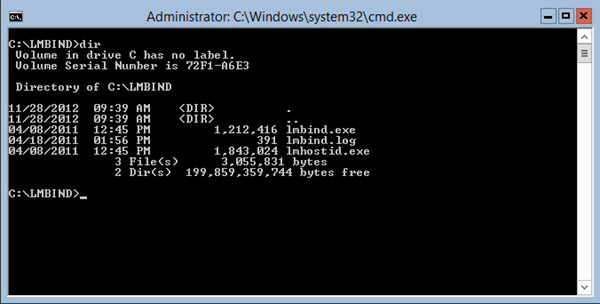
Type "lmhostid -ptype LMB -ether" (without the quotes) and press Enter - a "Host ID" will be displayed...
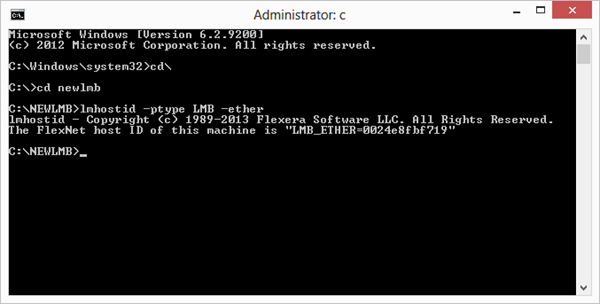
Write down the Host ID generated; everything within the quotation marks, in the example above, the host ID is "LMB_ETHER=0024e8fbf719"
This Host ID is based on the Hard Drive and Network Card ID for the host server. If you swap out the primary drive or NIC, the Host ID may change which will cause the vendor daemon (oncenter.exe) to stop serving licenses. Before swapping out server hardware, return all activation codes (see the Related article for instructions on Returning an Activation Code), swap the hardware, follow the instructions above to get the new
Host ID for the server, then re-activate the codes using the new Host ID. You will be prompted to confirm the change in Host ID.
If your HOST Server has multiple NICs installed, LMHostID will generate a Host ID for each NIC - that's OK, just use the first one generated.
Next, type "lmbind" (without the quotes) and press Enter. (You may specify a port using the "-p" switch, or let the operating system assign the port, by default, LMBind uses port 27010 - if you change the port here, you must specify the same the port in the Environmental Variable in the virtual server, see Related articles.)
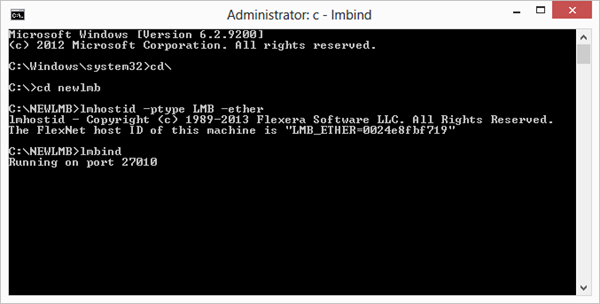
This starts the LMBind process.
Note the Port on which the LMBind process is running, you will need this when installing Enterprise License Manager - Virtual Server Edition on the virtual server. In our example above, LMBIND is running on port "27010" (the default port).
Microsoft Hyper-V Server
To run LMBind on a Microsoft Hyper-V host Host server, copy the folder "i86_n3" to the hard drive of the server (someplace where you can easily find the folder when you open a Command Prompt).
Windows Management Instrumentation (WMI) must be installed and running on your Hyper-V server to install and configure LMBind. See your Windows documentation for assistance.
When installing the binding agent on Microsoft HyperVisor server, the files are:
Once these files are copied to the host server's hard drive,
Open a command prompt on the host server
Navigate to the directory where the "lmbind.exe" and "lmhostid.exe" files are stored

Type "lmhostid -ptype HPV -vsn" (without the quotes) and press Enter
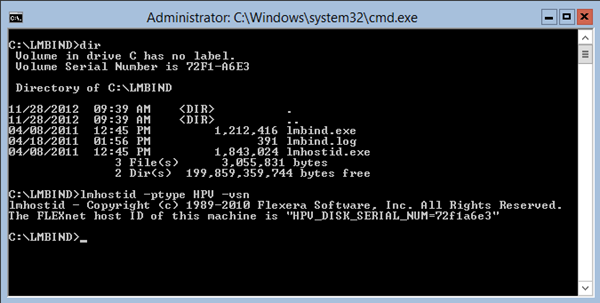
Write down the Host ID generated (everything within the quotation marks, in the example above, the host ID is "HPV_DISK_SERIAL_NUM=72f1a6e3"
This Host ID is based on the Hard Drive and Network Card ID for the host server. If you swap out the primary drive or NIC, the Host ID may change which will cause the vendor daemon (oncenter.exe) to stop serving licenses. Before swapping out server hardware, return all activation codes (see the Related article for instructions on Returning an Activation Code), swap the hardware, follow the instructions above to get the new
Host ID for the server, then re-activate the codes using the new Host ID. You will be prompted to confirm the change in Host ID.
If your HOST Server has multiple NICs installed, LMHostID will generate a Host ID for each NIC - that's OK, just use the first one generated.
Next, type "lmbind" (without the quotes) and press Enter (you may specify a port using the "-p" switch, or let the operating system assign the port, by default, LMBind uses port 27010 - if you change the port here, you must specify the same the port in the Environmental Variable in the virtual server, see Related articles)
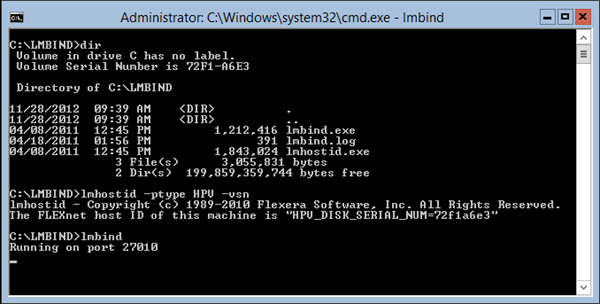
This starts the LMBind process.
Note the Port on which the LMBind process is running, you will need this when installing Enterprise License Manager - Virtual Server Edition on the virtual server. In our example above, LMBIND is running on port "27010".
As LMBind runs, it creates a log file in the same directory where the lmbind.exe file is stored. This file can assist with troubleshooting issues with the virtual server.
Reminder, be sure to configure this machine's firewall to allow incoming communications over the port on which LMBind is running.
VMWare ESX
To run LMBind on a VMWare ESX (not ESXi) host server, copy the folder "i86_lsb" to the hard drive of your ESX server (someplace where you can easily find the folder when you are in the ESX console).
If you are not running VMWare ESX or you want to install LMBind on a different physical server, use the "Bare Metal Binding" instructions above.
When installing the binding agent on VMWare ESX server, the files are:
Once these files are copied to the host server's hard drive,
Open a command prompt/terminal window on the host server
Set the directory to wherever the lmbind and lmhostid files are stored (our folder is named 'flexnet')
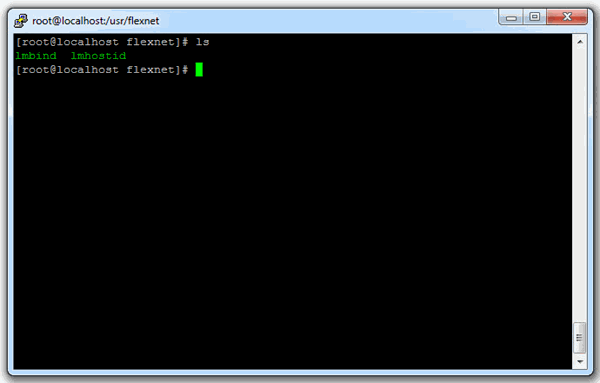
Type "lmhostid -ptype VMW -ether" (without the quotes) and press Enter
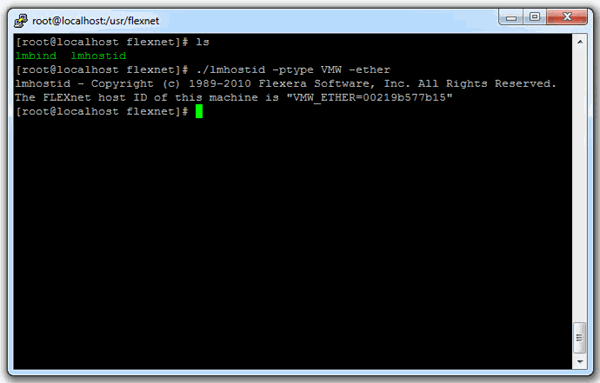
Write down the Host ID generated (everything within the quotation marks, in the example above the host ID is "VMW_ETHER=00219b577b15"
This Host ID is based on the Hard Drive and Network Card ID for the host server. If you swap out the primary drive or NIC, the Host ID may change which will cause the vendor daemon (oncenter.exe) to stop serving licenses. Before swapping out server hardware, return all activation codes (see the Related article for instructions on Returning an Activation Code), swap the hardware, follow the instructions above to get the new
Host ID for the server, then re-activate the codes using the new Host ID. You will be prompted to confirm the change in Host ID.
If your HOST Server has multiple NICs installed, LMHostID will generate a Host ID for each NIC - that's OK, just use the first one generated.
Next, type "./lmbind" (without the quotes) and press Enter (you may specify a port using the "-p" switch, or let the operating system assign the port. By default, LMBind uses port 27010 - if you change the port here, you must specify the same the port in the Environmental Variable in the virtual server (see Related articles)
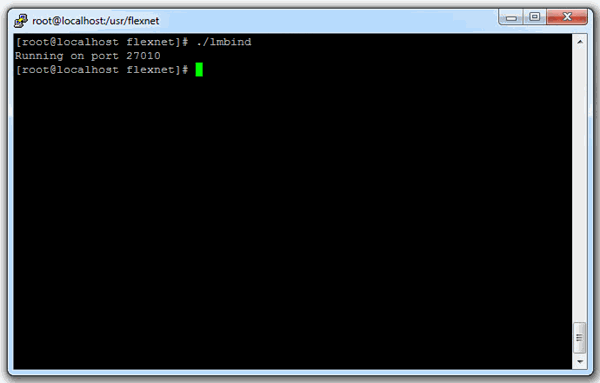
This starts the LMBind process.
The LMBind process must remain running on the physical machine at all times or the vendor daemon (oncenter.exe) will stop serving licenses. When you start an executable in a Linux environment (which is what VMWare ESX is, basically) it continues to run in the background usually. If you need help with copying files to an ESX server or running them or keeping them running, please contact your VMWare ESX vendor for technical support. On Center does not provide technical support for products we do not sell/distribute.
Note the Port on which the LMBind process is running, you will need this when configuring the Environmental Variable on the virtual server, after you install Enterprise License Manager Activation Utility (in the example above, lmbind is running on port "27010").
As LMBind runs, it creates a log file in the same directory where the lmbind file is stored. This file can assist with troubleshooting issues with the virtual server.
Please see the next article for instructions to configure LMBind/ELM.
Please review the ELM-Virtual Server Edition System Requirements and Troubleshooting Issues for more information.
